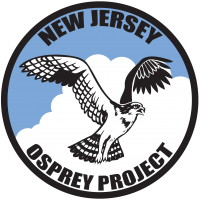New Jersey Osprey Project
Conserve Wildlife Foundation plays an active role in helping to manage and protect ospreys in New Jersey.
NEWS / Feb 8, 2024 -- Results from last year have been published in the 2023 New Jersey Osprey Project Report (link to Google Drive doc. 13 pg.). Findings include over 800 occupied nests, which is the most ever in the history of the project, which began in the early 1970s. Results also documented the lowest productivity rate since 2003, at 1.16 young/active-known outcome nest, and a 32% failure rate.
Historically, before the effects of DDT caused the state's osprey population to decline, over 500 osprey nests could be found along New Jersey's coastline. By the early 1970s, around 50 nests remained. The effects of DDT in the food chain caused reproduction to fail, and habitat was lost with a burgeoning shore population that eliminated many trees and increased ground predator populations. In New Jersey the osprey was listed as endangered in 1974 by the NJ Division of Fish, Game and Wildlife. Early recovery efforts began when DDT was banned in New Jersey in 1968. The highest levels of DDT were found on Barnegat Bay. In the early 1970's state biologists began an innovative recovery effort to place young and eggs from nests where DDT was not used as heavily into nests that failed to produce young, year after year. In addition, they coordinated efforts to supply man-made nest platforms for the birds. These new artificial nest platforms replaced the snags and trees that were lost as the barrier islands became more developed in the 1950s.
 | Ospreys: A Success Story (NJN video)The osprey was listed as endangered in 1974 after DDT and habitat loss decimated the population. The population dropped from 450-500 nesting pairs to only 53. Since the 70s the population has rebounded to historic levels. Here is a video of the New Jersey Osprey Recovery Project. |
By 1986 the osprey population had surpassed 100 pairs, sparking the decision to upgrade their status to threatened in the state. Since that time, the Endangered and Nongame Species Program staff has worked to monitor and manage the population, tracking their nest success every year with a core group of volunteers, and censusing the population every three years. In 2006 the NJ osprey population hit a new post-DDT record of just over 400 active nests, not far below the estimated historic population of 450 to 500 nests. In 2009, 486 nesting pairs were found and in 2011 biologists decided the postpone the next aerial survey until 2013.
 Zoom+ Show your love for the recovery of ospreys in New Jersey with an offical NJOP shirt! Northside Jim
Zoom+ Show your love for the recovery of ospreys in New Jersey with an offical NJOP shirt! Northside Jim
Today, Conserve Wildlife Foundation of NJ plays an active role in helping to manage and protect the statewide population of ospreys. It was our goal to help the population recover to the historic level of over 500 nesting pairs, which was surpassed in 2013. The New Jersey Osprey Project seeks to raise private funding through donations, fundraising campaigns, platform sponsorships, and educational presentations to help ospreys thrive in New Jersey. We also sponsor Eagle Scouts candidates with projects that seek to install and maintain osprey platforms along coastal areas of New Jersey.
Since 2004, we have installed over 200 nesting platforms throughout New Jersey, most in areas where suitable habitat exists with few nesting structures and others to replace old and unsafe structures. Around 75% of the known population nest on artificial nest platforms and they are crucial to the long term stability of the population. We have concentrated much of our work on Barnegat Bay, Little Egg Harbor, and Great Bay. We work very closely with the Endangered and Nongame Species Program and assist with osprey surveys and nestling banding during the nesting season from April 1 - August 31.
To follow our work with ospreys, follow NJ Osprey Project on Facebook.
HOW WE CAN HELP
We offer technical assistance to private consulting firms, individuals, school groups, environmental commissions, Boy Scouts, Girl Scouts, and anyone else who is interested in constructing and installing osprey nesting structures. We've consulted with individuals and contractors throughout the United States and abroad to help identify suitable habitat for the installation and/or repair of osprey nesting structures.
In New Jersey, we work with the NJ Division of Fish and Wildlife to help manage and monitor a very large database of existing nesting structures. We can help you choose the most suitable location to place a platform so it will not negatively impact any other species that live in the coastal area of the state.
We can provide maps, platform plans (see Publications below), and in some cases an actual platform. Please do not hesitate to contact us for more information or if you have a question.
HOW YOU CAN HELP
 Zoom+ In 2013 we released the locations of all known osprey nest sites in New Jersey. The purpose was to engage residents and collect data to help monitor our ospreys. Click here to view.
Zoom+ In 2013 we released the locations of all known osprey nest sites in New Jersey. The purpose was to engage residents and collect data to help monitor our ospreys. Click here to view.
Donate!
We do not receive any dedicated funding from the state or federal government! When we began working with ospreys in the mid-2000s, we saw how the lack of government funding was holding back the full recovery of ospreys in New Jersey by the lack of suitable nest structures for them to build nests along the coast. We began reaching out to private corporations, businesses and individuals to help bring in private funding to purchase materials to construct and install more nest platforms. We still rely on this philanthropic support to monitor and manage ospreys.
Report activity at nest sites
Since the beginning of the project annual nesting surveys have been completed to help track the size of the population. Our methods for monitoring the population have changed over time. Today, instead of using helicopters to fly along our coast, which was very expensive in the later days (2000s), we use volunteers who can cover just as much area with very little funding. In 2013 we partnered with the Center for Conservation Biology who founded Osprey Watch, a global osprey watching website. We released the location of over 800 nest sites in New Jersey. The goal for us was to use volunteers to report activity at nest sites during the osprey nesting season from April 1 to August 31. It was a huge success and a total of 542 nesting pairs were recorded. The next statewide census is planned for 2017.
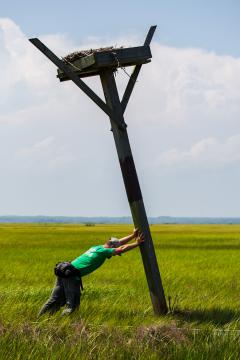 Zoom+ We help maintain hundreds of osprey nesting platforms along the coast of NJ. Please make a donation today to help us keep them all in good condition!
Zoom+ We help maintain hundreds of osprey nesting platforms along the coast of NJ. Please make a donation today to help us keep them all in good condition!
You can view all known nests in New Jersey and report activity at a nest near your house on our partner's website, Osprey-watch.org
Volunteer
Volunteers have been a very important component to the successful recovery of ospreys in New Jersey since the beginning of this project in 1974. We engage volunteers in all aspects of this conservation project. From constructing nesting platforms to installing them, we could use your help! If you have a boat, a ladder, some basic tools, then we can put you to work! Opportunities vary throughout the year and events occur on weekdays and weekends to help engage more people in our Osprey Project. Email Ben for more information or use the form below to sign up to receive future osprey related news and volunteer ops.
ADOPT AN OSPREY PLATFORM
Each year more and more platforms become damaged or even disappear during the winter months. With this new program individuals can "adopt" an existing osprey nest platform. Your donation will make sure this platform stays in pristine condition. If it ever becomes damaged or needs repair, we'll be there to do the work.
EDUCATIONAL PROGRAMS
Schedule an educational "New Jersey's Fish Hawk: The Amazing Osprey" presentation, which covers Osprey identification, life history, project history, human impacts, current management and their status. Program runs around 60 minutes. This is a great program for adults, high school students, civic organizations and scouting groups. Program honorarium: $250
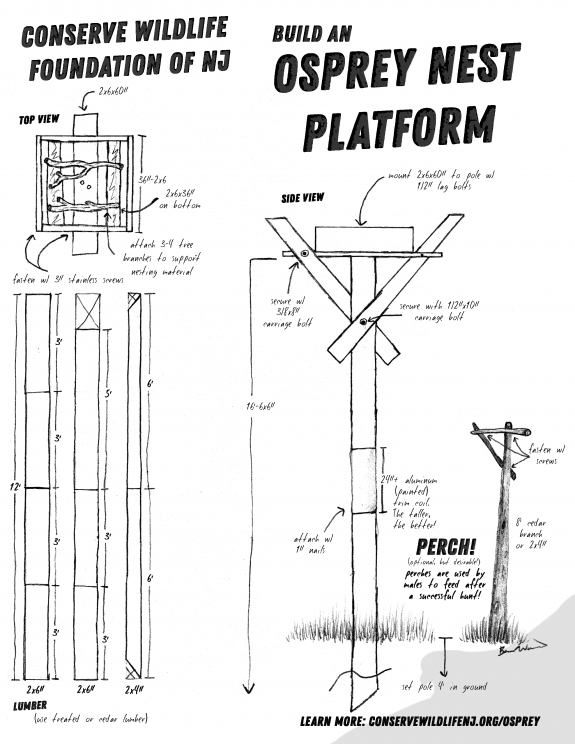 Zoom+ Download a PDF of plans and placement advice.
Zoom+ Download a PDF of plans and placement advice.
Marine Debris: A threat to ospreys, our bioindicator species
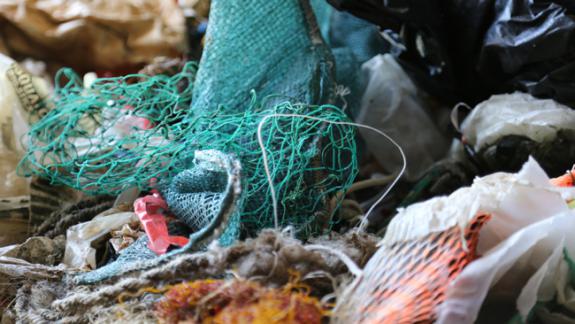 Ospreys use trash as nesting material because (sadly) it is a plentiful resource that collects in the upper areas of the saltmarsh. It is a deadly component of their nests that easily entangles them. Do your part and pick up litter if you see it. © Ben Wurst
Ospreys use trash as nesting material because (sadly) it is a plentiful resource that collects in the upper areas of the saltmarsh. It is a deadly component of their nests that easily entangles them. Do your part and pick up litter if you see it. © Ben Wurst
We've all seen the negative effects that we can have on our environment. One that we've been passionate about documenting and raising awareness about is the occurrence of plastic marine debris in osprey nests. Litter is almost everywhere and that includes active osprey nests. It winds up in the high marsh areas along our coast and that is where ospreys have always collected natural nesting material (sticks, eelgrass, muck, grasses and reeds). This new nesting material is not so safe for ospreys and their young. They can become easily entangled in ribbon from released balloons, monofilament from unwary fishermen, rope or twine, from lost crab pots or bait bags. For the past two years we've collected (and saved) trash we find in and around active nests. We're using this trash (aka marine debris) to use as a tool to help educate the public about this emerging threat to the ospreys and the health of our coastal ecosystem.
Please help us by sharing this blog post about the issue. To make the biggest impact, reduce the amount of trash you produce, reuse what you can’t recycle, recycle things that can be repurposed into new goods, and participate in local beach or stream cleanups! Thanks!!
- Sept 2018 Update: Documenting the presence of plastics in osprey nests
Osprey Nest Platform Placement and Nest Removal Guidelines
Each year, residents reach out with questions about how and where to install osprey nest platforms. In the beginning they were needed to help boost the statewide recovery of ospreys since their natural nests were lost from development along the coast. Today (2021-), we are not actively installing osprey nest platforms at new locations to expand their range. Since they have reached the pre-DDT population estimate, we are now shifting our focus to maintain existing and established nests, which is challenging given the size of the state population, few staff and little funding. New nest platforms are only being installed when an established nest needs to be relocated. Our goal is to support a stable population while allowing ospreys to colonize more natural sites that will become more available over time.
Active and inactive nests cannot be removed without a state depredation permit in New Jersey. During the non-breeding season (from Sept 1 to March 31) you do not need a federal depredation permit but you still need the state depredation permit. A depredation permit is not required when some nesting material is removed under normal maintenance of the structure, but when nests (including platforms) are removed and/or excluders are placed (which essentially “removes the nest”) then a state depredation permit is required.
>> View/download the latest Osprey Nest Guidance
Learn More:
- Osprey information including identification, life history, habitat, and current threats
- Artificial nesting platform placement guidance and information. Includes detailed information on how to select the proper location for a platform.
- NJ Division of Fish and Wildlife, Endangered and Nongame Species Program
- New Jersey Osprey Project on Facebook
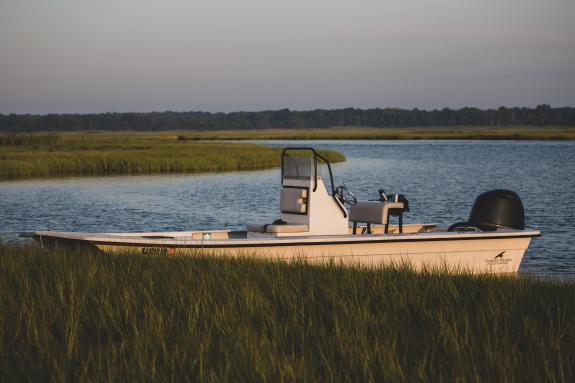 The boat we ended up getting for the New Jersey Osprey Project was a 2018 MayCraft 22' Skiff. A boat with nothing fancy, plenty of deck space and the ability for back bay, skinny water pursuits.
The boat we ended up getting for the New Jersey Osprey Project was a 2018 MayCraft 22' Skiff. A boat with nothing fancy, plenty of deck space and the ability for back bay, skinny water pursuits.
Publications:
New Jersey Osprey Project Brochure - 4.0MB |
Ospreys and Plastic Marine Debris - 3.3MB |
Build an Osprey Nest Platform 2019 - 3.1MB |
Adopt a Species - Osprey - 206.6KB |
2006 New Jersey Osprey Project - 138.4KB |
2007 New Jersey Osprey Project - 113.6KB |
2008 New Jersey Osprey Project - 210.6KB |
2009 New Jersey Osprey Project - 157.1KB |
2010 New Jersey Osprey Project - 178.0KB |
2011 New Jersey Osprey Project - 74.4KB |
2012 New Jersey Osprey Project Newsletter - 76.5KB |
2013 New Jersey Osprey Project Newsletter - 106.2KB |
2014 New Jersey Osprey Project Newsletter - 208.7KB |
2015 New Jersey Osprey Report - 2.1MB |
2016 New Jersey Osprey Project - 910.8KB |
2017 New Jersey Osprey Project Report - 627.2KB |
2018 New Jersey Osprey Project Report - 11.6MB |
2019 New Jersey Osprey Project Report - 4.1MB |
>> 2020 New Jersey Osprey Project Report summarizes results from surveys conducted throughout the state which documented over 500 active nests.
>> 2021 New Jersey Osprey Project Report includes a detailed findings and summary of results from the following year which include over 700 occupied nests.
>> 2022 New Jersey Osprey Project Report details results of the statewide osprey survey and census which recorded a total of 733 nests.
>> 2023 New Jersey Osprey Project Report which includes results from nesting surveys that documented 808 occupied nests.
 Zoom+ Photo essay in the The Sandpaper, Sept. 2014 covering Project RedBand. The Sandpaper
Zoom+ Photo essay in the The Sandpaper, Sept. 2014 covering Project RedBand. The Sandpaper
In the News:
- Boy Scouts help install osprey platforms in Ocean City - NJ.com
- Ospreys get a boost from Boy Scouts in Ocean City - AC Press
- New Jersey's osprey population continues to grow along coastal regions, report states - NJ.com
- New Jersey's Ospreys Back from Near Extinction - Chinatopix.com
- New Jersey Osprey Population is Growing: Threatened Species Script Amazing Comeback - Tech Times
- New Jersey Turns to Citizen Observers for Osprey - NBC40 Philadelphia
- N.J. osprey monitoring to shift from scientists to citizens - Philly.com
- Osprey numbers on the rise in NJ says foundation - Courier-Post News
- 2/6/18 - Most Productive Year Ever for NJ Ospreys - WHYY
- 2/12/19 - NJ Sees Record Number of Ospreys in 2018 - NJ101.5
- June 27, 2013 - Toms River Patch - Island Beach's Osprey receive tracking bands - video
- June 8th, 2011 - The SandPaper - Humans Help Ospreys Soar by Juliet Kaszas-Hoch
The Sandpaper article - July 8, 2008 - 2.0MB |
The Sandpaper article - September 17, 2008 - 915.1KB |
The Sandpaper article - November 10, 2010 - 642.4KB |
Historic Documents:
Osprey Egg Transplant Program a Success - NJ Outdoors 1974 - 987.8KB |
Contact Us:
Ben Wurst, Senior Wildlife Biologist: Email





